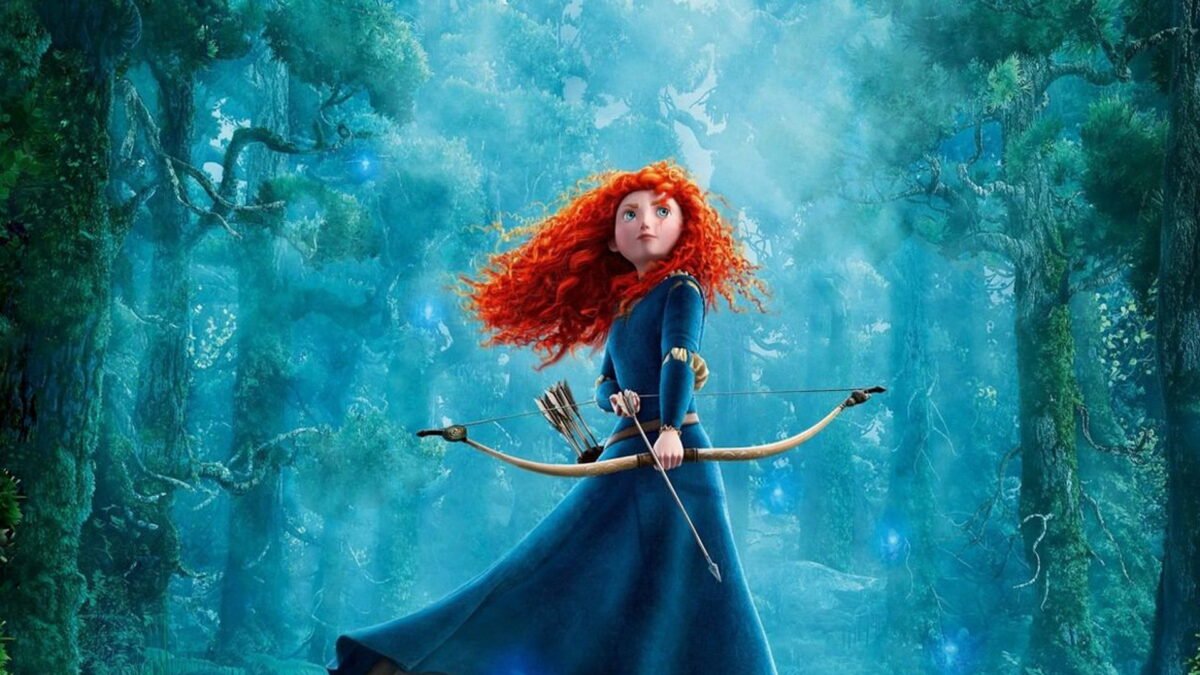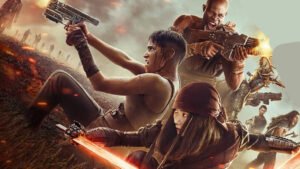As long as the Walmart approved comedy kryptonite Larry The Cable Guy isn’t involved, you simply can’t go wrong with a Pixar movie.
By virtue of the fact that when they launched the first full-length CGI animated film with Toy Story the company essentially killed off hand drawn animation, there should be some sort of resentment directed towards the Oscar-gobbling animation behemoth. Yet Pixar just gets better and better, cranking out contemporary classics like The Incredibles, Ratatouille, Wall-E, Finding Nemo, and Up at will. This week Pixar launches their latest summer classic in Brave, which according to the marketing material appears to be a bland CGI post-millennial twist on the Disney princess genre.
Of course, Pixar being Pixar it’s another hilarious, emotionally complex, beautifully animated work geared to anyone who will stick their eyeballs in front of it rather than children needing a blockbuster babysitter. Brave sits comfortably with the rest of the studio’s output and if anything might be soft-peddled with critical acclaim simply because we’ve come to expect this excellence from Pixar. We got the chance to chat with Brave’s co-director Mark Andrews and producers Katherine Sarafian about their wonderful film during a trip to Toronto and picked their brain about the creation of another animation classic, which is just business as usual around their sacred offices.

Could you talk a little bit about the arc of Brave’s heroine? It isn’t your standard heroic arc.
Mark Andrews: Well, we had to figure out the character. She was headstrong and willful, but she also has to be appealing because I didn’t want to go through the whole movie hating the main character. I want to like her by the end and be aware that she’s going through this transition of adolescence to adulthood that she has to learn all these lessons. But I am totally behind her for being all the ways that she is. It’s a really delicate balance to strike.
That’s a lot of trial and error to line up those things. I mean, we hated her in some early drafts for a long time. The main character was (so spiteful) and the mother was like Mommy Dearest, she was awful. We made her this wicked, evil queen. It actually wasn’t even until we had Kelly on board and she lent her voice to this character that it came together. We could hear the stuff in the script when we read it to each other, and we were getting there, maybe 70% of the way there, because you could read it and think that it was still on that teenage side of being too unlikable.
Katherine Sarafian: Appeal is a huge thing.
Mark Andrews: Appeal is magic. It’s an alchemy, but we fell in love with her from the first line out of her mouth.
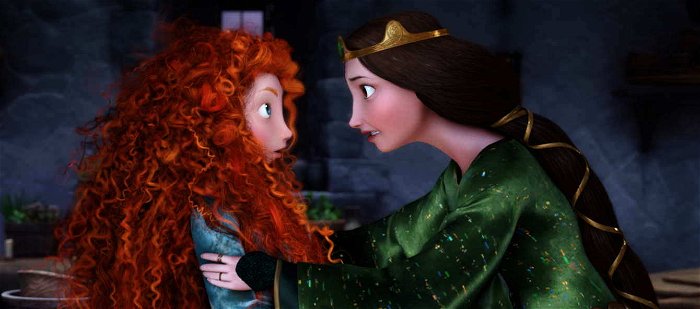
Katherine Sarafian: Even through things like character design and storyboards when you’re just sketching everything out using a pencil, no matter how big her smile is or how wide her eyes are, appeal is something you have to always strive for. It’s appeal plus character design, and then it becomes appeal plus character movement. You need to have that before you have the voice, and then casting is pretty much all about appeal, appeal, appeal, because you’re going to be putting your characters through some gnarly stuff, and the audience has to stay with them. We can never underestimate the importance of appeal.
Mark Andrews: It’s the biggest part of making the script work, because what is appeal? And it goes just from your gut. And when we know the story’s on the right track, it’s from the gut and it just feels right. And that’s something that no matter how hard I try, I just can’t articulate it at all. Neither can Andrew Stanton, or John Lassetter, or Steven Spielberg, or James Cameron. They can’t do it. They have ideas, but they can’t be right all the time, because if they were right all the time they would be walking out with Academy Awards all the time, and they’re not! It’s hard.
Katherine Sarafian: This even goes back to the days of Toy Story with Woody the Cowboy. That came out all the way back in 1995 and that was a hard thing to land the appeal for. He was a pull-string cowboy and he was a jerk. You’ll hear Andrew and John constantly bickering back and forth that he just lacked appeal. He was really snarky and kind of underhanded, and they really had to work to get that likeability out of that character. They found it a bit, but Tom Hanks ultimately became what was needed to give it that appeal.
Mark Andrews: Like, I talked to Emma Thompson about her character here [Merida’s mother, the Queen] to tell her that we as an audience have to be able to laugh at her at times. Because as soon as you say a character is royalty, there’s a certain connotation that you have to treat them with respect, but you really don’t. You can be bawdy, and fun, and lighthearted, and comic. It just makes her real.
There has been a lot of talk about Merida being the first female protagonist for a Pixar project and I was wondering if that seems odd to you and if that decisions added any pressure when creating this character?
Mark Andrews: Oh yeah, totally. It is weird because it’s not like we have a big dry erase board with a list of all the future Pixar movies like (assumes dramatic voice), first the girl picture then the giraffe picture, then something in Saudi Arabia, then talking squirrels. If we were focused on that aspect, a marketing aspect or what we haven’t done, then we’d be playing to that instead of focusing on the strengths of the character and the story and building it from the ground up. So it’s always the things that we are inspired by create the story. I don’t blame anyone as we’re releasing it for focusing on about it being the first female protagonist because that’s new. We’ve had strong female characters in our movies before, but more in a supporting role.
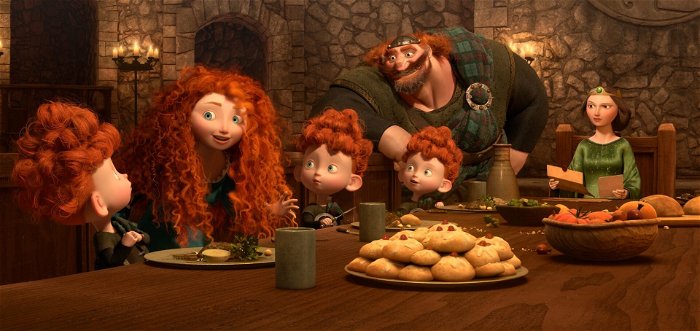
It’s our first period piece as well. I think that while there are a lot of firsts here, it still is a regular Pixar film. You are going to get a unique take on something that you haven’t seen before. There have been talking animal pictures before, but Finding Nemo was different. There had been superhero pictures before but The Incredibles is still a great one because it has that strong family dynamic. So, we’re still very much in the cannon of Pixar, which means that you’re going to get something different, you don’t know what to expect, but trust us it’s going to be good. I kind of like that everyone is gravitating to these specifics about it so then when people actually go to the theater they’ll be like, “it was more than just a movie about one girl or about Scotland.”
We get a lot of questions about that stuff, but it just came from our interests. I have an affinity for Scotland and so does Brenda [Chapman, co-director]. They have ripe oral history, the land is just awash with myths and legends. There are other places just as beautiful, but I don’t get as spooked out by them. It’s a very unique place.
Katherine Sarafian: I’m learning as we’re promoting Brave what a big deal it is that this is our first female protagonist. As Mark said, as we made Brave the focus was just on creating the best character. We have an awareness that Pixar hasn’t had a female driving the story forward in the past, but it wasn’t until we started talking about it that we became aware of what a big deal it is. But it is, so we’ll trudge forward with that awareness now, knowing that audiences want something more out of their female characters.
Mark Andrews: And we were aware that Disney has done the princess…you know, a lot. We knew we had a princess and that serves the story, but we knew we were making a kind of anti-princess. She’s everything that a princess is not. That’s why we had the whole scene of “a princess is this, a princess does that,” so that we could abolish all of those things. She’s not even good at any of those things that she’s supposed to do! Being a princess and being a woman are two very different things, or at least can be. We didn’t want to follow those old adages of “you have to be saved” or “you have to fall in love to be complete.” She’s not questing for a happily ever after. She’s trying to find out who she is and how she fits into this world on her own terms. That’s very inspirational, I think and a good change.
Speaking of inspirations, I was wondering if you could chat a little bit more about your artistic inspirations for this movie? For instance, I saw a lot of Miyazaki in the character designs.

Mark Andrews: Yeah, we had some great character designers on our art team. Steve Purcell is just a fantastic designer. He comes out of children’s books and he’s known for his texture and the roundness of the form that he creates. So there are a lot of influences. I love Miyazaki films, but I love all anime. I wasn’t there for the design process, but everybody had input, and they were being designed and driven by what the story requires. I think Miyazaki is a good reference because he just goes in there and takes inspiration from what’s in his stories, he’s not redesigning it.
He makes the characters simple enough that we get who they are and they fit with the environment. Steve did the same thing. Here we have an actual Scotland and we’re going to create a highly characterized version so that it’s almost hyper-realistic. I wouldn’t call it photorealistic, but it feels like you could touch it. So the characters had to feel like they belonged in that world and still have a softness at the same time. It’s always to serve the story so that there’s a sense of visual storytelling going on at all times that conveys information without me having to type words to explain something through exposition. That way, the dialogue is just the icing on the cake.
Katherine Sarafian: We take inspiration from everything in our lives. Every movie we’ve seen or—
Mark Andrews: There’s a little Conan in there and some Excalibur or Ridley Scott. That’s what’s made me who I am, so those things are going to get jumbled up inside and comes out as something new.
Katherine Sarafian: Any Star Wars in there?
Mark Andrews: Of course there’s Star Wars in there! If you look at this and play Star Wars at the same time they line up cut-to-cut. It’s amazing.
Katherine Sarafian: We have laminated cards in story meetings and one is a Star Wars card so that you can only make one Star Wars reference per day. If you mention Star Wars in the story room, then you have to turn in your card and can’t mention it for the rest of the day.
Mark Andrews: It was debilitating.
Katherine Sarafian: I think our creativity is shaped by everything we see and experience including Miyazaki, but I think what the cool thing about Brave is that everything is grounded in something real. We didn’t have to look to other films for inspiration all the time because we could look to Scotland and the natural qualities. So we felt that was more interesting to us that other texts, for the most part.

How important were research trips to Scotland you took for Brave and what impact that had on the final product?
Mark Andrews: She actually organized it based on the honeymoon that I took with my wife. It all began with a honeymoon.
Katherine Sarafian: We took two trips for research. The first was in late August 2006, with twelve artists in twelve days. The second was in October 2007, which was seven artists in seven days Really, the first trip was storyboard artists, myself and Mark and Brenda the directors. We weren’t sure where to go, but Mark had this really great story about having his honeymoon in Scotland and only having four days in Edinburgh knowing that he could have stayed there for months, so he asked a cab driver for suggestions on where to go. We went to all of those places with sketchbooks, paints, pastels, and cameras.
Mark Andrews: We went skinny dipping in lochs, laid down in the heather.
Katherine Sarafian: It was about smelling everything, touching everything, and drawing. We also talked to a lot of people because we wanted to hear not just the accents, but their sense of storytelling. We went to a pub and played some music. We bought people beer and once you do that they’re very happy to open up and tell you stories. We looked at the faces and felt the weather. All of these things really played in directly to the final film.
Mark Andrews: Yeah, you get all these assets by really going. Because we could easily look it up on the web and get pictures. There are plenty of books and articles that have been written. You can gather a lot of information that way, but that’s only here (points at head), that’s not here (points at heart). To get that, you have to go there. Once you get it there, then you can get it on the page or into a painting, or tell someone else about it because you’ll have details you wouldn’t have otherwise. That’s incredibly valuable.
Katherine Sarafian: The scale of things makes a huge difference as well. Like the Calanais Stones. We saw them in a book and wanted to include them, but then when you get there they are just huge. There are things that you really have to see to experience. I always come back to those because you see the pictures and think, “oh very striking, very beautiful, we should put a story point there.”
But then once we got there and actually see them, everyone went silent and sketched. It was such a meditative place. Nobody decided not to speak, but it happened once we got there and got that feeling. That sort of experience changes how you think of it and that changes that story point and what you do with that setting in the movie. That became a big story point where she went to the witch’s cottage. So, those trips were incredibly important.
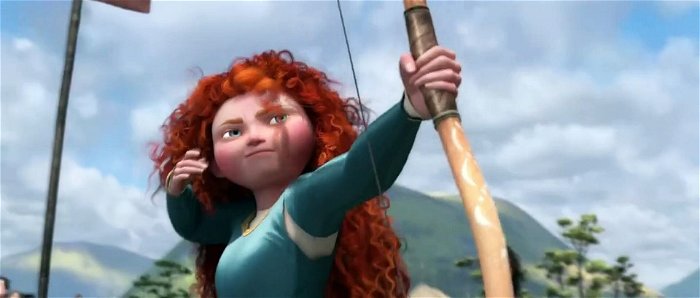
During the voiceover recording, were the actors able to interact or were they able to do things separately?
Mark Andrews: All done separately.
Katherine Sarafian: They all interacted back when they all did other movies together in the past. (Laughs) They all knew each other really well. Some had even seen each other even as early as the previous week, and some had directed each other in different things. But we never were able to get any of them together in the same room.
Mark Andrews: It’s just too difficult to get everyone in there. I did that back in school when I was still going through film school. I would have my actors all record at the same time back then, but I know that Kevin Kline and Kenneth Branagh did that back in the day with The Road to El Dorado where they only record at the same time, but they set all that up in their contracts. It’s hard because you know it’s all about building up the performances. That’s why you do several different takes and one person’s coming on strong and I knew there’s another great take where the person they’re acting with is kind of diminished, then I can form a rhythm and a pattern out of all the different takes.
Katherine Sarafian: We have quite the international cast, and we’re in the position where all of them were gainfully employed doing other things. With Kelly Macdonald, she was busy with Boardwalk Empire so she was in New York. With Billy Connolly, he was always doing comedy tours so he was always in Australia or New York or wherever he was doing a shot at any given time. Robbie Coltrane was usually in Glasgow or London most of the time. Kevin McKidd and Craig Ferguson, usually in LA. I think we would have loved to have them all in one room, but if you asked us if we would do it this way again we would say yes because it was the only way to get all of these actors in the first place. They were the right ones for the roles.
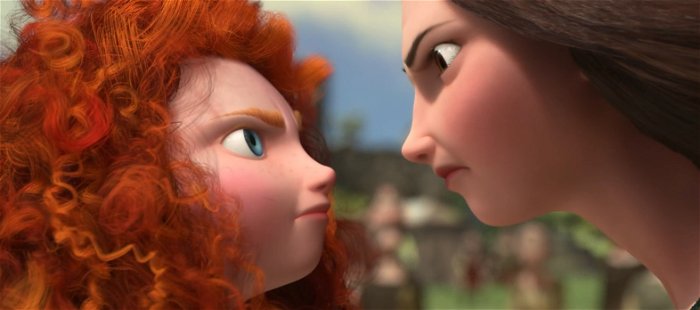
The relationship between Merida and her mother really tapped into identifiable family grief. Was that one of the hardest things to get right?
Mark Andrews: It was. We worked on that particular ending quite a bit. Once we discovered that we wanted to build everything up that resolution, having that play out just right was very difficult. I mean, we overwrote it and kept cutting it to play out just right. We were using our own experiences and trying as hard as possible to look at it as an audience, just to feel it. Because if we’re feeling it then we must be in the right zone.
Katherine Sarafian: We ended up with a fairly spare version compared to where we started where everything was spelled out in dialogue. It’s always a holistic approach. We try to look at these things from every angle. Once we had that combined with Patrick Doyle’s score and the echo of the song that they had song back in the childhood moment, it felt like it hit that emotional core much more strongly than just having characters talk about it. But it took us a long time to get there. We always knew what the scene was and what we wanted it to do, but we kept messing with it until we got there.
